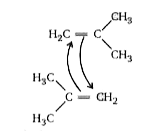Which carbon in the following molecule has most electron density?
CH3−CH2−CH2−FIII II I
I
II
III
all are indentical
The correct Answer is:C
To determine which carbon in the molecule CH3−CH2−CH2−F has the most electron density, we need to analyze the effects of the electronegative fluorine atom on the carbon atoms.
1. Identify the Structure:
The molecule consists of three carbon atoms (C1, C2, C3) and one fluorine atom (F) attached to the last carbon (C3). The structure can be represented as:
CH3−CH2−CH2−F
Here, C1 is the first carbon (attached to three hydrogens), C2 is the second carbon (attached to two hydrogens), and C3 is the third carbon (attached to one hydrogen and one fluorine).
2. Understand the Inductive Effect:
The fluorine atom is highly electronegative and will withdraw electron density from the adjacent carbon (C3) due to the inductive effect. This effect is known as the -I effect (negative inductive effect), which means that electronegative atoms pull electron density towards themselves.
3. Analyze the Distance:
The inductive effect decreases with increasing distance from the electronegative atom. Therefore, the carbon atoms closer to fluorine (C3) will experience a stronger withdrawal of electron density compared to those further away (C1 and C2).
4. Evaluate Each Carbon:
- C1: This carbon is farthest from the fluorine and will experience the least inductive effect. It retains more electron density.
- C2: This carbon is in the middle; it experiences some inductive effect from fluorine but less than C3.
- C3: This carbon is directly attached to fluorine, so it loses electron density due to the -I effect. It will have less electron density compared to C1 and C2.
5. Conclusion:
Since C1 is the farthest from the electronegative fluorine and experiences the least withdrawal of electron density, it retains the most electron density. Therefore, the carbon with the most electron density in the molecule is C1.
Final Answer:
The carbon with the most electron density is C1.
The molecule consists of three carbon atoms (C1, C2, C3) and one fluorine atom (F) attached to the last carbon (C3). The structure can be represented as:
CH3−CH2−CH2−F
Here, C1 is the first carbon (attached to three hydrogens), C2 is the second carbon (attached to two hydrogens), and C3 is the third carbon (attached to one hydrogen and one fluorine).
The fluorine atom is highly electronegative and will withdraw electron density from the adjacent carbon (C3) due to the inductive effect. This effect is known as the -I effect (negative inductive effect), which means that electronegative atoms pull electron density towards themselves.
The inductive effect decreases with increasing distance from the electronegative atom. Therefore, the carbon atoms closer to fluorine (C3) will experience a stronger withdrawal of electron density compared to those further away (C1 and C2).
- C1: This carbon is farthest from the fluorine and will experience the least inductive effect. It retains more electron density.
- C2: This carbon is in the middle; it experiences some inductive effect from fluorine but less than C3.
- C3: This carbon is directly attached to fluorine, so it loses electron density due to the -I effect. It will have less electron density compared to C1 and C2.
Since C1 is the farthest from the electronegative fluorine and experiences the least withdrawal of electron density, it retains the most electron density. Therefore, the carbon with the most electron density in the molecule is C1.
The carbon with the most electron density is C1.
Topper's Solved these Questions
- PERIODIC PROPERTIES OF ELEMENTSBOOK - VMC MODULES ENGLISHCHAPTER - PERIODIC PROPERTIES OF ELEMENTSEXERCISE - ENABLE
47 Videos
- PERIODIC PROPERTIES OF ELEMENTSBOOK - VMC MODULES ENGLISHCHAPTER - PERIODIC PROPERTIES OF ELEMENTSEXERCISE - EFFICIENT
50 Videos
- p-BLOCK ELEMENTS-1BOOK - VMC MODULES ENGLISHCHAPTER - p-BLOCK ELEMENTS-1EXERCISE - JEE Advanced Archive
48 Videos
- QUIZBOOK - VMC MODULES ENGLISHCHAPTER - QUIZEXERCISE - CHEMISTRY
30 Videos
Similar Questions
Knowledge Check
Which of the following best describes the flow of electrons in the acid-catalyzed dimerization of (CH3)2C=CH2 ?
A B
B C
C D
D
Which of the following has an asymmetric carbon atom ?
(a)CH3−CH2−CH2Br
(b)CH3−H∣C∣Br−C∣CH3H−CH3
(c)CH3−cH2−Br∣C∣CH3−CH3
(d)CH3−∣CH3∣C∣Br−CH2−CH2−CH3ACH3−CH2−CH2BrBCH3−H∣C∣Br−C∣CH3H−CH3CCH3−cH2−Br∣C∣CH3−CH3DCH3−∣CH3∣C∣Br−CH2−CH2−CH3
Which of the following is the correct ease of dehydration ?
I CH3−CH2−CH2−CH2∣OH , II CH3−CH2−OH∣CH−CH3 , III CH2=CH−OH∣CH−CH3, IV

View SolutionWhich of the following compounds can form carbanion easily ?
I. CH3CH2 II. CH3CHO III. CH3CH2Cl IV.
The correct choice is :
View SolutionEncircle the molecule as directed :
Which has a higher boiling point : CH3−CH2−OH or CH3−CH=O
View SolutionWhich of the following is the correct increasing order of boiling point of following compounds ?
I CH3−CH2−CH2OH, II CH3−CH∣OH−CH3 , III CH3−O−CH2−CH3
View SolutionWhich hybrid orbitals are used by carbon atoms in the following molecules?
(a)CH3−CH3,(b)CH3−CH=CH2,(c)CH3−CH2OH,
(d)CH3−CHO,(e)CH3−CHO (f)CH3COOH
View SolutionWhich of the following compounds will show cis-trans isomerism?
(i) (CH3)2C=CH−C2H5
(ii) CH2=CBr2
(iii) C6H5CH=CH−CH3
CH3CH=CClCH3
View Solution
